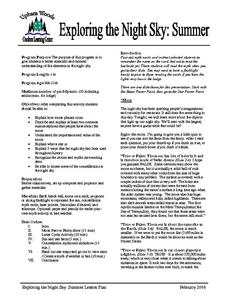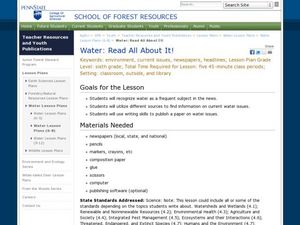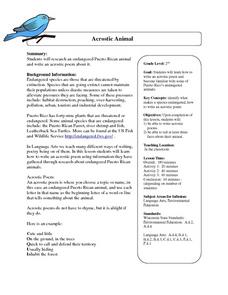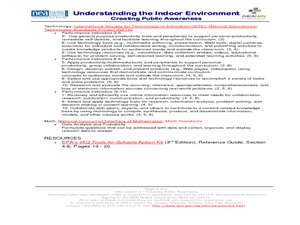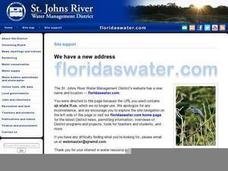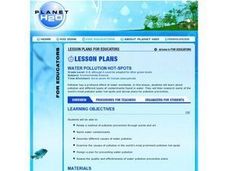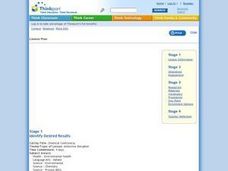Curated OER
What Is El Niño?
Students access information at remote sites using telecommunications, identify impacts by reviewing past El Ni??o events, make and use scale drawings, maps, and maps symbols to find locations and describe relationships.
Curated OER
Potential Consequences of Climate Variability and Change
Students examine the potential impact of climate change to agriculture, coastal areas, forests, water, and human health. They hypothesize what might happen to a sugar maple forest and hold a debate about global warming.
Curated OER
Exploring the Hudson in 1609
Learners follow the journey of Henry Hudson down the river with his name. Using journal entries and maps, they learn about its exploration. They use maps to identify stages of the journey, and practice converting distances into miles.
Curated OER
Mammal Mobile
Short but sweet. Younger learners will view images and hear about the characteristics that make-up mammals, they will then discuss why a particular animal is, or is not, a mammal providing specific details. They will then create a mammal...
Curated OER
Nesting Bird
Your class will love this lesson! Learners discuss the birds they have seen in their region and create a collage. The collage contains a picture of a tree, a bird, and the bird's nest. As an extension, they can learn about the specific...
Curated OER
The Sounds Of Nature
Second graders investigate the concept of sounds in nature. The sound of a coqui frog is used as an example. They identify species of frogs by listening to the sounds they make. Also, 2nd graders experience and identify other sounds of...
Curated OER
Water Cycle Terrariums
Learners explore the water cycle. They build a model of the water cycle in the form of a terrarium and explain how it demonstrates the water cycle. In addition, they draw a representation of the water cycle demonstrated in the terrarium.
Curated OER
Exploring the Night Sky: Summer
Students explain how moon phases occur. They describe and explain at least two common misconceptions that people have about the moon. Students explain what a star is. They explain 3 ways that the night sky has been used throughout history.
Curated OER
Water: Read All About It!
Students discuss newspapers and water and work in groups to develop their own paper focusing on water issues. In this journalism lesson, students discuss the value of newspapers and water as an issue. They work as a group to develop a...
Curated OER
Cardboard Tree and Endangered Animals Lesson
Students create endangered animal figures and their habitats.
Curated OER
Pollution Prevention in Schools
Students review P2 concepts they learned in previous lessons and explore how to reduce the pollution in their school. They also examine ways to conserve energy.
Curated OER
Talkin' Trash (All About Landfills)
Students investigate the types of waste created by people and identify various options for trash disposal. They read and discuss a handout about what a landfill is and the different types of trash, match types of trash with the proper...
Curated OER
Biosphere II
Students continue their examination of the existence of life on Earth. In groups, they determine the role of the water cycle and other biogeochemical cycles play in keeping balance on Earth. They participate in experiments to discover...
Curated OER
Recycling by Composting
Students examine the idea of recycling by composting. Using the internet, they research the benefits of composting to the environment. In groups, they collect numbers on how much food and yard waste is produced in their community. ...
Curated OER
Junk Mail Overload!
Students discuss the "junk mail nuisance" with the teacher and share their opinions on the problem. Students collect a week's worth of junk mail, bring to class and complete a chart about the amount and weight. Students then complete an...
Curated OER
Settling The Wasterwater Problem
High schoolers name models that are representations of larger objects. They suggest ways that industry, agriculture, and mining affect water quality. Pupils demonstrate the use of lagoons for treating wastewater. Students define the...
Curated OER
Global Warming
Students examine how human produced emissions of carbon dioxide contribute to global warming. Using the internet, they research the future effects of global warming on the Earth. In groups, they discover ways to reduce daily energy...
Curated OER
Acrostic Animal
Second graders listen as the teacher describes how an acrostic poem is written. They research an endangered animal of Puerto Rico. Students write an acrostic poem as a class, and then individually about the animal they research. Students...
Curated OER
Creating Public Awareness - Indoor Air Quality
Students design a poster about indoor air quality. In this indoor air quality lesson plan, students make a billboard that tells the occupants of a building about at least one air quality problem.
Curated OER
How to Catch a Fish
Learners conduct an experiment to demonstrate the effects of different fishing methods. In this commercial fishing lesson students create posters and public announcements to share their information.
Curated OER
Lesson 11 - Potable Water
Students investigate the meaning of potable water and water reuse. They define water quality and quantity problems. They complete worksheets, a quiz and design a poster.
Curated OER
Water Pollution Hot-Spots
Young scholars complete internet research in small groups to identify types of water pollution, spotlight water pollution hot-spots, and design a plan for water prevention.
Curated OER
Chemical Controversy
Students explore the endocrine disruption theory. They work in groups to research and develop a persuasive oral argument to support one side of the endocrine disruption theory. Students engage in debate and other activities to analyze...
Curated OER
Water Ways Lesson Plan #1: Who Catches Your Fish?
Students explore the types of fish caught in the Mid-Atlantic region. In this fishing lesson plan, students learn about fishing methods and meet fishermen that catch the fish. Using the water ways website, students research types of...









